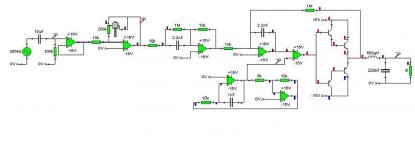Hello everyone,
For my A level electronics project I have built a class D amp.
It works but the quality is poor. When I put a scope on the triangle wave generator it was producing a square wave with sloped sides. I believe this could be due to the speed of the op amp (23v/us). Although with the frequency being 100KHz this should not happen. Does anyone have any ideas as to the problem or any suggestions of how I could improve my design?
Also does anyone know of a good high speed op amp that would work in this design im looking at about 200v/us?
Thanks
Rob
For my A level electronics project I have built a class D amp.
It works but the quality is poor. When I put a scope on the triangle wave generator it was producing a square wave with sloped sides. I believe this could be due to the speed of the op amp (23v/us). Although with the frequency being 100KHz this should not happen. Does anyone have any ideas as to the problem or any suggestions of how I could improve my design?
Also does anyone know of a good high speed op amp that would work in this design im looking at about 200v/us?
Thanks
Rob
It depends on the schematic. May be first of all you should check the NFB (negative feed back). If it's "open" you'll see similar effect.
After a quick look, your NFB resistor looks too big to me. Also crocclips isn't always a very nice program when simulating amplifiers...
Do you know a way to calculate the feed back resistor?
What program is good for simulating amplifers? I have looked for livewire but cant find a torrent.
What program is good for simulating amplifers? I have looked for livewire but cant find a torrent.
The triangle wave generator have to produce good triangle.
The output pulses (before the filter) have to be square, w/o frequency change. The width ratio of +/- pulses produces output sound signal.
NFB resistor determines the gain. You can vary it. But control the stability. Too deep FB (small resistor) can make the circuit unstable.
The output pulses (before the filter) have to be square, w/o frequency change. The width ratio of +/- pulses produces output sound signal.
NFB resistor determines the gain. You can vary it. But control the stability. Too deep FB (small resistor) can make the circuit unstable.
I suggest that you have a look at Class-D article at ESP (www.sound.au.com) website.
Have a look also at one thread I started here, with a deep discussion about feedback and estability. (the name is something like "help with feedback").
Best regards,
Pierre
Have a look also at one thread I started here, with a deep discussion about feedback and estability. (the name is something like "help with feedback").
Best regards,
Pierre
- Status
- Not open for further replies.
- Home
- Amplifiers
- Class D
- Class D help!
